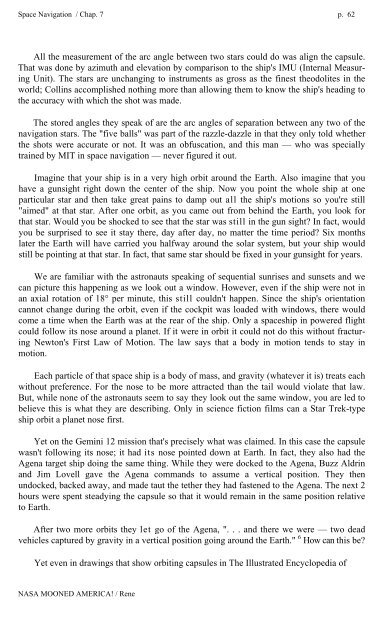Rene-NASA-Mooned-America
Rene-NASA-Mooned-America
Rene-NASA-Mooned-America
Create successful ePaper yourself
Turn your PDF publications into a flip-book with our unique Google optimized e-Paper software.
Space Navigation / Chap. 7 p. 62<br />
All the measurement of the arc angle between two stars could do was align the capsule.<br />
That was done by azimuth and elevation by comparison to the ship's IMU (Internal Measuring<br />
Unit). The stars are unchanging to instruments as gross as the finest theodolites in the<br />
world; Collins accomplished nothing more than allowing them to know the ship's heading to<br />
the accuracy with which the shot was made.<br />
The stored angles they speak of are the arc angles of separation between any two of the<br />
navigation stars. The "five balls" was part of the razzle-dazzle in that they only told whether<br />
the shots were accurate or not. It was an obfuscation, and this man — who was specially<br />
trained by MIT in space navigation — never figured it out.<br />
Imagine that your ship is in a very high orbit around the Earth. Also imagine that you<br />
have a gunsight right down the center of the ship. Now you point the whole ship at one<br />
particular star and then take great pains to damp out all the ship's motions so you're still<br />
"aimed" at that star. After one orbit, as you came out from behind the Earth, you look for<br />
that star. Would you be shocked to see that the star was still in the gun sight In fact, would<br />
you be surprised to see it stay there, day after day, no matter the time period Six months<br />
later the Earth will have carried you halfway around the solar system, but your ship would<br />
still be pointing at that star. In fact, that same star should be fixed in your gunsight for years.<br />
We are familiar with the astronauts speaking of sequential sunrises and sunsets and we<br />
can picture this happening as we look out a window. However, even if the ship were not in<br />
an axial rotation of 18° per minute, this still couldn't happen. Since the ship's orientation<br />
cannot change during the orbit, even if the cockpit was loaded with windows, there would<br />
come a time when the Earth was at the rear of the ship. Only a spaceship in powered flight<br />
could follow its nose around a planet. If it were in orbit it could not do this without fracturing<br />
Newton's First Law of Motion. The law says that a body in motion tends to stay in<br />
motion.<br />
Each particle of that space ship is a body of mass, and gravity (whatever it is) treats each<br />
without preference. For the nose to be more attracted than the tail would violate that law.<br />
But, while none of the astronauts seem to say they look out the same window, you are led to<br />
believe this is what they are describing. Only in science fiction films can a Star Trek-type<br />
ship orbit a planet nose first.<br />
Yet on the Gemini 12 mission that's precisely what was claimed. In this case the capsule<br />
wasn't following its nose; it had its nose pointed down at Earth. In fact, they also had the<br />
Agena target ship doing the same thing. While they were docked to the Agena, Buzz Aldrin<br />
and Jim Lovell gave the Agena commands to assume a vertical position. They then<br />
undocked, backed away, and made taut the tether they had fastened to the Agena. The next 2<br />
hours were spent steadying the capsule so that it would remain in the same position relative<br />
to Earth.<br />
After two more orbits they let go of the Agena, ". . . and there we were — two dead<br />
vehicles captured by gravity in a vertical position going around the Earth." 6 How can this be<br />
Yet even in drawings that show orbiting capsules in The Illustrated Encyclopedia of<br />
<strong>NASA</strong> MOONED AMERICA! / <strong>Rene</strong>


